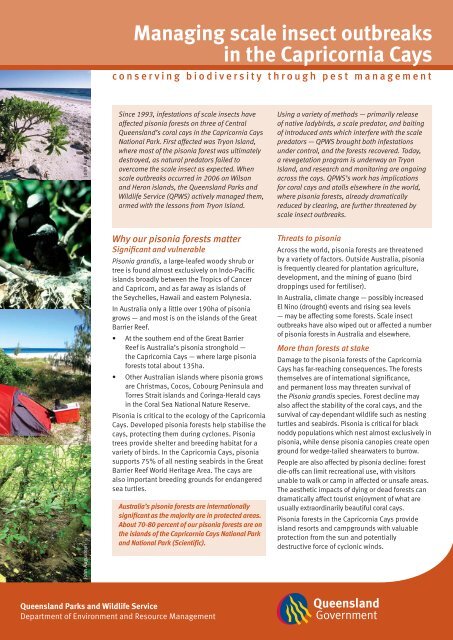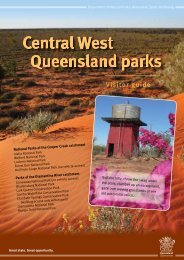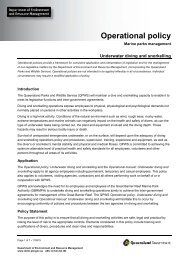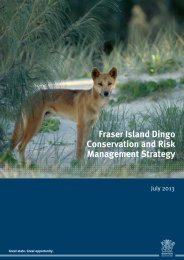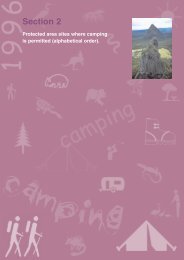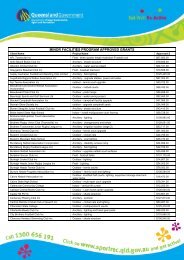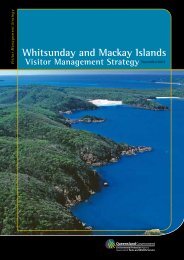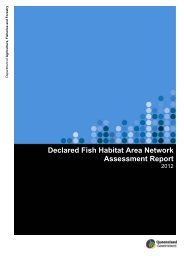Managing scale insect outbreaks in the Capricornia Cays
Managing scale insect outbreaks in the Capricornia Cays
Managing scale insect outbreaks in the Capricornia Cays
You also want an ePaper? Increase the reach of your titles
YUMPU automatically turns print PDFs into web optimized ePapers that Google loves.
<strong>Manag<strong>in</strong>g</strong> <strong>scale</strong> <strong><strong>in</strong>sect</strong> <strong>outbreaks</strong><br />
<strong>in</strong> <strong>the</strong> <strong>Capricornia</strong> <strong>Cays</strong><br />
conserv<strong>in</strong>g biodiversity through pest management<br />
John Augusteyn<br />
S<strong>in</strong>ce 1993, <strong>in</strong>festations of <strong>scale</strong> <strong><strong>in</strong>sect</strong>s have<br />
affected pisonia forests on three of Central<br />
Queensland’s coral cays <strong>in</strong> <strong>the</strong> <strong>Capricornia</strong> <strong>Cays</strong><br />
National Park. First affected was Tryon Island,<br />
where most of <strong>the</strong> pisonia forest was ultimately<br />
destroyed, as natural predators failed to<br />
overcome <strong>the</strong> <strong>scale</strong> <strong><strong>in</strong>sect</strong> as expected. When<br />
<strong>scale</strong> <strong>outbreaks</strong> occurred <strong>in</strong> 2006 on Wilson<br />
and Heron islands, <strong>the</strong> Queensland Parks and<br />
Wildlife Service (QPWS) actively managed <strong>the</strong>m,<br />
armed with <strong>the</strong> lessons from Tryon Island.<br />
Us<strong>in</strong>g a variety of methods — primarily release<br />
of native ladybirds, a <strong>scale</strong> predator, and bait<strong>in</strong>g<br />
of <strong>in</strong>troduced ants which <strong>in</strong>terfere with <strong>the</strong> <strong>scale</strong><br />
predators — QPWS brought both <strong>in</strong>festations<br />
under control, and <strong>the</strong> forests recovered. Today,<br />
a revegetation program is underway on Tryon<br />
Island, and research and monitor<strong>in</strong>g are ongo<strong>in</strong>g<br />
across <strong>the</strong> cays. QPWS’s work has implications<br />
for coral cays and atolls elsewhere <strong>in</strong> <strong>the</strong> world,<br />
where pisonia forests, already dramatically<br />
reduced by clear<strong>in</strong>g, are fur<strong>the</strong>r threatened by<br />
<strong>scale</strong> <strong><strong>in</strong>sect</strong> <strong>outbreaks</strong>.<br />
John Augusteyn<br />
Mark Coombe<br />
John Augusteyn<br />
Why our pisonia forests matter<br />
Significant and vulnerable<br />
Pisonia grandis, a large-leafed woody shrub or<br />
tree is found almost exclusively on Indo-Pacific<br />
islands broadly between <strong>the</strong> Tropics of Cancer<br />
and Capricorn, and as far away as islands of<br />
<strong>the</strong> Seychelles, Hawaii and eastern Polynesia.<br />
In Australia only a little over 190ha of pisonia<br />
grows — and most is on <strong>the</strong> islands of <strong>the</strong> Great<br />
Barrier Reef.<br />
• At <strong>the</strong> sou<strong>the</strong>rn end of <strong>the</strong> Great Barrier<br />
Reef is Australia’s pisonia stronghold —<br />
<strong>the</strong> <strong>Capricornia</strong> <strong>Cays</strong> — where large pisonia<br />
forests total about 135ha.<br />
• O<strong>the</strong>r Australian islands where pisonia grows<br />
are Christmas, Cocos, Cobourg Pen<strong>in</strong>sula and<br />
Torres Strait islands and Cor<strong>in</strong>ga-Herald cays<br />
<strong>in</strong> <strong>the</strong> Coral Sea National Nature Reserve.<br />
Pisonia is critical to <strong>the</strong> ecology of <strong>the</strong> <strong>Capricornia</strong><br />
<strong>Cays</strong>. Developed pisonia forests help stabilise <strong>the</strong><br />
cays, protect<strong>in</strong>g <strong>the</strong>m dur<strong>in</strong>g cyclones. Pisonia<br />
trees provide shelter and breed<strong>in</strong>g habitat for a<br />
variety of birds. In <strong>the</strong> <strong>Capricornia</strong> <strong>Cays</strong>, pisonia<br />
supports 75% of all nest<strong>in</strong>g seabirds <strong>in</strong> <strong>the</strong> Great<br />
Barrier Reef World Heritage Area. The cays are<br />
also important breed<strong>in</strong>g grounds for endangered<br />
sea turtles.<br />
Australia’s pisonia forests are <strong>in</strong>ternationally<br />
significant as <strong>the</strong> majority are <strong>in</strong> protected areas.<br />
About 70-80 percent of our pisonia forests are on<br />
<strong>the</strong> islands of <strong>the</strong> <strong>Capricornia</strong> <strong>Cays</strong> National Park<br />
and National Park (Scientific).<br />
Threats to pisonia<br />
Across <strong>the</strong> world, pisonia forests are threatened<br />
by a variety of factors. Outside Australia, pisonia<br />
is frequently cleared for plantation agriculture,<br />
development, and <strong>the</strong> m<strong>in</strong><strong>in</strong>g of guano (bird<br />
dropp<strong>in</strong>gs used for fertiliser).<br />
In Australia, climate change — possibly <strong>in</strong>creased<br />
El N<strong>in</strong>o (drought) events and ris<strong>in</strong>g sea levels<br />
— may be affect<strong>in</strong>g some forests. Scale <strong><strong>in</strong>sect</strong><br />
<strong>outbreaks</strong> have also wiped out or affected a number<br />
of pisonia forests <strong>in</strong> Australia and elsewhere.<br />
More than forests at stake<br />
Damage to <strong>the</strong> pisonia forests of <strong>the</strong> <strong>Capricornia</strong><br />
<strong>Cays</strong> has far-reach<strong>in</strong>g consequences. The forests<br />
<strong>the</strong>mselves are of <strong>in</strong>ternational significance,<br />
and permanent loss may threaten survival of<br />
<strong>the</strong> Pisonia grandis species. Forest decl<strong>in</strong>e may<br />
also affect <strong>the</strong> stability of <strong>the</strong> coral cays, and <strong>the</strong><br />
survival of cay-dependant wildlife such as nest<strong>in</strong>g<br />
turtles and seabirds. Pisonia is critical for black<br />
noddy populations which nest almost exclusively <strong>in</strong><br />
pisonia, while dense pisonia canopies create open<br />
ground for wedge-tailed shearwaters to burrow.<br />
People are also affected by pisonia decl<strong>in</strong>e: forest<br />
die-offs can limit recreational use, with visitors<br />
unable to walk or camp <strong>in</strong> affected or unsafe areas.<br />
The aes<strong>the</strong>tic impacts of dy<strong>in</strong>g or dead forests can<br />
dramatically affect tourist enjoyment of what are<br />
usually extraord<strong>in</strong>arily beautiful coral cays.<br />
Pisonia forests <strong>in</strong> <strong>the</strong> <strong>Capricornia</strong> <strong>Cays</strong> provide<br />
island resorts and campgrounds with valuable<br />
protection from <strong>the</strong> sun and potentially<br />
destructive force of cyclonic w<strong>in</strong>ds.<br />
Queensland Parks and Wildlife Service<br />
Department of Environment and Resource Management
Scale <strong><strong>in</strong>sect</strong> and pisonia<br />
A balanced relationship<br />
The soft <strong>scale</strong> <strong><strong>in</strong>sect</strong>, Pulv<strong>in</strong>aria urbicola,<br />
is a t<strong>in</strong>y <strong><strong>in</strong>sect</strong> (around 2–3mm long)<br />
that lives on <strong>the</strong> leaves of a number of<br />
plants, <strong>in</strong>clud<strong>in</strong>g pisonia. ‘Scale’ <strong><strong>in</strong>sect</strong>s<br />
get <strong>the</strong>ir name from <strong>the</strong>ir scaly protective<br />
covers, although <strong>in</strong> ‘soft’ <strong>scale</strong>s this is<br />
usually absent.<br />
DERM<br />
Pisonia forests play<br />
a critical role <strong>in</strong><br />
<strong>the</strong> ecology of <strong>the</strong><br />
<strong>Capricornia</strong> <strong>Cays</strong>,<br />
which are places<br />
of extraord<strong>in</strong>ary<br />
beauty and<br />
ecological diversity.<br />
When <strong>the</strong> balance goes wrong<br />
Sometimes, however, <strong>the</strong> number<br />
of <strong>scale</strong> <strong><strong>in</strong>sect</strong>s <strong>in</strong> a pisonia forest<br />
explodes, creat<strong>in</strong>g an ‘outbreak’. In<br />
response to <strong>the</strong> <strong>in</strong>creased food supply,<br />
<strong>outbreaks</strong> are also accompanied by<br />
an explosion <strong>in</strong> <strong>the</strong> number of ants –<br />
particularly <strong>the</strong> <strong>in</strong>troduced African<br />
big-head ant Pheidole megacephala<br />
<strong>in</strong> <strong>the</strong> <strong>Capricornia</strong> <strong>Cays</strong>.<br />
Under <strong>the</strong> stress of such large numbers<br />
of <strong>scale</strong>, pisonia trees respond as<br />
if drought-stressed and drop <strong>the</strong>ir<br />
leaves. Scale eggs are plentiful and<br />
<strong>the</strong>ir highly mobile larvae will move,<br />
or be blown or carried on to o<strong>the</strong>r<br />
trees. The orig<strong>in</strong>al trees start to recover<br />
and form new leaf buds, but are soon<br />
recolonised by <strong>scale</strong> and ants. Pisonia<br />
trees can go through a number of<br />
defoliations, over several months or<br />
a couple of years, before eventually<br />
dy<strong>in</strong>g if <strong>the</strong> outbreak cont<strong>in</strong>ues.<br />
A global problem<br />
S<strong>in</strong>ce <strong>the</strong> early 1990s, <strong>scale</strong> <strong>outbreaks</strong><br />
are known to have occurred on three<br />
of <strong>the</strong> islands of <strong>the</strong> <strong>Capricornia</strong> <strong>Cays</strong><br />
National Park: Tryon, Wilson and Heron.<br />
Dur<strong>in</strong>g <strong>the</strong> same period, <strong>scale</strong> <strong>outbreaks</strong><br />
have also affected pisonia forests<br />
elsewhere. The pisonia forest on<br />
Cor<strong>in</strong>ga Island <strong>in</strong> Australia’s Coral Sea<br />
was completely destroyed by <strong>scale</strong><br />
<strong><strong>in</strong>sect</strong> dur<strong>in</strong>g <strong>the</strong> 1990s. Scale has also<br />
severely damaged pisonia forests on<br />
Bird Island <strong>in</strong> <strong>the</strong> Seychelles and<br />
Palmyra Atoll <strong>in</strong> Hawaii.<br />
Scale <strong><strong>in</strong>sect</strong> <strong>outbreaks</strong> are a threat<br />
to pisonia forests worldwide. The<br />
work of QPWS <strong>in</strong> manag<strong>in</strong>g <strong>scale</strong> on<br />
<strong>the</strong> <strong>Capricornia</strong> <strong>Cays</strong> is vital not just<br />
for <strong>the</strong> protection of Queensland’s<br />
islands, but for cays and atolls<br />
across <strong>the</strong> world.<br />
John Augusteyn<br />
Soft <strong>scale</strong> appear as greenish-brown blisters<br />
and <strong>in</strong> outbreak you can see lots of white<br />
woolly-like egg masses.<br />
Scale <strong><strong>in</strong>sect</strong>s suck sap from <strong>the</strong>ir host<br />
plant to survive. They also produce<br />
a sweet, sticky substance called<br />
‘honeydew’, which is a food source<br />
for many common ant species. Ants<br />
attracted by honeydew will farm <strong>scale</strong><br />
and often <strong>in</strong>terfere with <strong>the</strong>ir predators;<br />
<strong>the</strong>y may even move <strong>scale</strong> eggs to new<br />
sites. Our current understand<strong>in</strong>g is that<br />
this mutually beneficial relationship<br />
between <strong>scale</strong> and ants is a normal,<br />
balanced situation.<br />
Scale <strong><strong>in</strong>sect</strong>s seem to occur naturally<br />
throughout healthy pisonia forests <strong>in</strong><br />
very low numbers — less than one or two<br />
<strong>scale</strong> to a leaf. For <strong>the</strong> most part, <strong>the</strong>ir<br />
numbers appear to be held <strong>in</strong> check by<br />
natural factors, especially predators such<br />
as native ladybirds and parasitic wasps.<br />
John Augusteyn<br />
Pisonia grandis leaf, African big-head<br />
ants Pheidole megacephala, and soft<br />
<strong>scale</strong> <strong><strong>in</strong>sect</strong> Pulv<strong>in</strong>aria urbicola.<br />
John Olds
<strong>Manag<strong>in</strong>g</strong> <strong>outbreaks</strong> <strong>in</strong><br />
<strong>the</strong> <strong>Capricornia</strong> <strong>Cays</strong><br />
Tryon Island — grow<strong>in</strong>g<br />
a new pisonia forest<br />
In August 1993, an outbreak of <strong>the</strong> <strong>scale</strong><br />
<strong><strong>in</strong>sect</strong> was detected <strong>in</strong> Tryon Island’s<br />
pisonia forest. At this time, Tryon’s<br />
pisonia covered nearly half <strong>the</strong> island.<br />
This was <strong>the</strong> first known <strong>scale</strong> outbreak<br />
<strong>in</strong> a pisonia forest of <strong>the</strong> <strong>Capricornia</strong><br />
<strong>Cays</strong>, and one of <strong>the</strong> world’s earliest<br />
records. Expectations were that natural<br />
predators — ladybirds and parasitic<br />
wasps — would br<strong>in</strong>g <strong>the</strong> outbreak<br />
under control. At various po<strong>in</strong>ts <strong>the</strong><br />
forests appeared to be recover<strong>in</strong>g,<br />
with previously affected trees show<strong>in</strong>g<br />
new growth. Ultimately <strong>the</strong> repeated<br />
<strong>scale</strong> <strong>in</strong>festations killed many pisonia,<br />
tak<strong>in</strong>g 7–8 years before <strong>scale</strong> numbers<br />
subsided. Even after <strong>the</strong> outbreak had<br />
ended, <strong>the</strong> forest did not regenerate as<br />
might have been expected. Today, 90<br />
percent of Tryon Island’s orig<strong>in</strong>al pisonia<br />
forest has gone.<br />
All is not lost, however. Once it became<br />
clear that <strong>the</strong> forest could not recover<br />
naturally, QPWS began a revegetation<br />
program. Trial plant<strong>in</strong>gs <strong>in</strong> 2004<br />
and 2005 <strong>in</strong>dicated a need for more<br />
detailed <strong>in</strong>vestigations, and a more<br />
comprehensive trial began <strong>in</strong> July 2006.<br />
QPWS staff and a team of volunteers are<br />
work<strong>in</strong>g to determ<strong>in</strong>e <strong>the</strong> most effective<br />
techniques for regenerat<strong>in</strong>g pisonia.<br />
A successful ant-bait<strong>in</strong>g program has<br />
also significantly reduced Tryon Island’s<br />
<strong>in</strong>troduced ant population, with no<br />
visible effects on native species.<br />
Tryon Island (along with Cor<strong>in</strong>ga Island <strong>in</strong><br />
<strong>the</strong> Coral Sea) also gave QPWS important<br />
<strong>in</strong>sights <strong>in</strong>to effective management of<br />
<strong>scale</strong> <strong>outbreaks</strong>. The ma<strong>in</strong> lesson was<br />
that like a wildfire, once underway,<br />
<strong>outbreaks</strong> of this k<strong>in</strong>d apparently will<br />
not subside before most, if not all, <strong>the</strong><br />
island’s pisonia is gone.<br />
<strong>Capricornia</strong> <strong>Cays</strong><br />
Tryon Island<br />
North West Island<br />
Tropic of Capricorn<br />
Irv<strong>in</strong>g Reef<br />
Polmaise Reef<br />
Ersk<strong>in</strong>e Island<br />
Heron Island<br />
Mas<strong>the</strong>ad Island<br />
Wistari Reef<br />
North Reef<br />
Wilson Island — manag<strong>in</strong>g an<br />
outbreak through ants and ladybirds<br />
In May 2006, QPWS rangers discovered<br />
a <strong>scale</strong> <strong><strong>in</strong>sect</strong> outbreak on Wilson Island.<br />
The island’s 2.4ha pisonia forest was <strong>in</strong><br />
<strong>the</strong> early stages of <strong>in</strong>festation.<br />
Armed with <strong>the</strong> lessons from Tryon<br />
Island and <strong>the</strong> previous successful<br />
predator and parasite releases <strong>in</strong> <strong>the</strong><br />
Coral Sea, QPWS responded quickly. In<br />
early June ant bait was used to almost<br />
elim<strong>in</strong>ate <strong>the</strong> <strong>in</strong>troduced ants on <strong>the</strong><br />
Island. Two weeks later, 5000 native<br />
ladybirds (Cryptolaemus montrouzieri)<br />
were released. Ladybirds are natural<br />
<strong>scale</strong> predators, frequently seen <strong>in</strong> low<br />
numbers on <strong>the</strong> <strong>Capricornia</strong> <strong>Cays</strong>.<br />
Surpris<strong>in</strong>gly, however, by early August,<br />
<strong>the</strong> outbreak had cont<strong>in</strong>ued to spread,<br />
and 90 percent of Wilson Island’s forest<br />
was affected. Unusually cold w<strong>in</strong>ter<br />
temperatures might have prevented<br />
<strong>the</strong> ladybirds from reproduc<strong>in</strong>g. In<br />
August, 2500 more ladybirds were<br />
released, this time successfully<br />
reproduc<strong>in</strong>g <strong>in</strong> September’s warmer<br />
spr<strong>in</strong>g temperatures. By early October,<br />
<strong>scale</strong> numbers had started to fall under<br />
pressure from <strong>the</strong> now several hundred<br />
thousand ladybird larvae and adults. By<br />
early December 2006, <strong>the</strong> outbreak was<br />
over and <strong>the</strong> forest was <strong>in</strong> recovery.<br />
Broomfield Cay<br />
Wilson Island<br />
Wreck Island<br />
Sykes Reef<br />
Lamont Reef<br />
One Tree Island<br />
Fitzroy<br />
Reef<br />
Llewellyn<br />
Reef<br />
Legend<br />
Boult Reef<br />
Hoskyn Islands<br />
Reef<br />
Shoal edge<br />
<strong>Capricornia</strong> <strong>Cays</strong> National Park<br />
<strong>Capricornia</strong> <strong>Cays</strong> National Park<br />
(Scientific) – no access<br />
Gladstone<br />
Scale<br />
0<br />
5<br />
nautical miles<br />
0 5 10 15<br />
kilometres<br />
Fairfax Islands<br />
Lady Musgrave Island<br />
Great Barrier Reef<br />
World Heritage Area<br />
Tropic of Capricorn<br />
Capricorn <strong>Cays</strong><br />
National Park<br />
Native ladybirds Cryptolaemus montrouzieri<br />
are natural predators of <strong>scale</strong>, and central to<br />
manag<strong>in</strong>g <strong>outbreaks</strong>.<br />
Heron Island — early detection<br />
and success<br />
Also <strong>in</strong> May 2006, staff from Heron<br />
Island resort contacted QPWS regard<strong>in</strong>g<br />
a suspected <strong>scale</strong> outbreak on a small<br />
group of pisonia trees with<strong>in</strong> <strong>the</strong> resort<br />
area (most of <strong>the</strong> island’s 13.6ha forest<br />
was unaffected). Prun<strong>in</strong>g and ant bait<strong>in</strong>g<br />
immediately controlled <strong>the</strong> outbreak on<br />
<strong>the</strong> lower leaves of affected trees and<br />
Heron Island’s parasitic wasps did <strong>the</strong> rest.<br />
10<br />
John Olds<br />
QPWS has learned that<br />
detection of <strong>outbreaks</strong><br />
at <strong>the</strong> earliest possible<br />
stages is essential.<br />
Detection must <strong>the</strong>n be<br />
followed by <strong>in</strong>tervention<br />
to bolster natural<br />
enemies of <strong>scale</strong> and<br />
reduce <strong>in</strong>terference from<br />
ants to help pisonia<br />
forests survive. This<br />
<strong>in</strong>formation was crucial<br />
<strong>in</strong> manag<strong>in</strong>g an outbreak<br />
on Wilson Island.<br />
John Olds<br />
Volunteers help with Tryon Island’s<br />
pisonia revegetation program.<br />
Scale <strong>outbreaks</strong> can devastate<br />
a pisonia forest.<br />
Mark Coombe
What causes <strong>outbreaks</strong>?<br />
Research<strong>in</strong>g <strong>the</strong> cause<br />
The causes of <strong>scale</strong> <strong>outbreaks</strong> are still<br />
unclear. QPWS is explor<strong>in</strong>g a range of<br />
possibilities. It is likely that a number of<br />
factors comb<strong>in</strong>e to cause an outbreak.<br />
A natural phenomenon?<br />
Scale <strong>outbreaks</strong> could be caused by<br />
natural decl<strong>in</strong>es <strong>in</strong> <strong>the</strong> number of natural<br />
predators, such as native ladybirds<br />
and parasitic wasps. This is most likely<br />
on smaller cays, where lower diversity<br />
means <strong>the</strong>re may be few or no hosts,<br />
<strong>in</strong>clud<strong>in</strong>g <strong>scale</strong>, for natural predators<br />
and parasites.<br />
Introduced ants?<br />
Introduced ants have been found at <strong>the</strong><br />
site of <strong>scale</strong> <strong>outbreaks</strong> <strong>in</strong> Australia and<br />
elsewhere. Their role <strong>in</strong> farm<strong>in</strong>g <strong>scale</strong><br />
and <strong>in</strong>terfer<strong>in</strong>g with natural parasites and<br />
predators may be central to ma<strong>in</strong>ta<strong>in</strong><strong>in</strong>g<br />
an outbreak. In <strong>the</strong> <strong>Capricornia</strong> <strong>Cays</strong>,<br />
<strong>the</strong> African big-head ant Pheidole<br />
megacephala is associated with all<br />
<strong>outbreaks</strong>, whereas <strong>in</strong> <strong>the</strong> Coral Sea it is<br />
<strong>the</strong> gu<strong>in</strong>ea ant Tetramorium bicar<strong>in</strong>atum.<br />
Genetic variation?<br />
Pisonia may have slightly different<br />
genetic stra<strong>in</strong>s on different islands,<br />
which may be more or less resistant to<br />
<strong>scale</strong> attack. There may also be different<br />
genetic stra<strong>in</strong>s of <strong>scale</strong> that are more or<br />
less resistant to predators.<br />
Seabird decl<strong>in</strong>e?<br />
Seabirds nourish pisonia forests by<br />
provid<strong>in</strong>g large amounts of nutrients,<br />
nitrogen, phosphorous and calcium<br />
through <strong>the</strong>ir dropp<strong>in</strong>gs. If seabirds are<br />
absent or <strong>in</strong> decl<strong>in</strong>e, pisonia forests<br />
may suffer nutrient stress, mak<strong>in</strong>g <strong>the</strong>m<br />
more vulnerable to <strong>scale</strong> attack. Climate<br />
change is likely to be a key factor <strong>in</strong><br />
changes to seabird populations.<br />
Drought?<br />
Dur<strong>in</strong>g drought, plants are water<br />
stressed. Stressed plants are more<br />
susceptible to <strong><strong>in</strong>sect</strong> attack and <strong>in</strong><br />
some cases drought favours <strong><strong>in</strong>sect</strong>s.<br />
© State of Queensland.<br />
Queensland Parks and Wildlife Service 2010.<br />
BP1763 January 2010.<br />
Recycled paper saves energy and resources.<br />
Where to from here?<br />
An ongo<strong>in</strong>g effort<br />
<strong>Manag<strong>in</strong>g</strong> and research<strong>in</strong>g <strong>scale</strong> <strong><strong>in</strong>sect</strong><br />
<strong>outbreaks</strong> <strong>in</strong> <strong>the</strong> <strong>Capricornia</strong> <strong>Cays</strong> is an<br />
ongo<strong>in</strong>g effort.<br />
On Tryon Island, revegetation will<br />
require many more years of plant<strong>in</strong>g,<br />
sampl<strong>in</strong>g and monitor<strong>in</strong>g. Across <strong>the</strong><br />
<strong>Capricornia</strong> <strong>Cays</strong>, QPWS is monitor<strong>in</strong>g<br />
<strong>scale</strong> and ant populations to help<br />
detect and prevent fur<strong>the</strong>r <strong>outbreaks</strong>.<br />
Staff are also monitor<strong>in</strong>g pisonia forest<br />
distribution and any changes that may<br />
arise from past <strong>scale</strong> <strong>in</strong>festations.<br />
Data collected from all this fieldwork<br />
is <strong>the</strong>n analysed and <strong>in</strong>corporated <strong>in</strong>to<br />
<strong>the</strong> research be<strong>in</strong>g carried out by QPWS<br />
scientists and its partners.<br />
QPWS staff are also develop<strong>in</strong>g<br />
procedures and promotional campaigns<br />
to reduce <strong>the</strong> spread of pests between<br />
islands <strong>in</strong> <strong>the</strong> <strong>Capricornia</strong> <strong>Cays</strong>.<br />
A collaborative effort<br />
QPWS is collaborat<strong>in</strong>g with a range of<br />
respected <strong>in</strong>stitutions <strong>in</strong> its work on<br />
<strong>scale</strong> <strong><strong>in</strong>sect</strong> <strong>outbreaks</strong>.<br />
The Queensland Herbarium is contribut<strong>in</strong>g<br />
<strong>in</strong>formation about cay soils and <strong>the</strong> health<br />
of pisonia forests, and report<strong>in</strong>g on cay<br />
vegetation communities. Queensland’s<br />
Department of Primary Industries<br />
and Fisheries is provid<strong>in</strong>g expert<br />
entomological advice, and assistance<br />
<strong>in</strong> analys<strong>in</strong>g, sort<strong>in</strong>g and collect<strong>in</strong>g data<br />
on ants and o<strong>the</strong>r <strong>in</strong>vertebrate fauna.<br />
The Australian Government Department<br />
of <strong>the</strong> Environment and Water Resources<br />
is shar<strong>in</strong>g its knowledge on manag<strong>in</strong>g<br />
<strong>scale</strong> <strong>outbreaks</strong> on <strong>the</strong> pisonia <strong>in</strong> <strong>the</strong><br />
Coral Sea cays.<br />
A global outcome<br />
The QPWS research on <strong>scale</strong> <strong>outbreaks</strong><br />
is of <strong>in</strong>ternational significance. Scale<br />
<strong><strong>in</strong>sect</strong>s are a global threat to pisonia.<br />
Research be<strong>in</strong>g carried out here will<br />
provide vital <strong>in</strong>formation on <strong>the</strong> best way<br />
to respond to an outbreak, <strong>in</strong>clud<strong>in</strong>g<br />
optimal methods of ant control and<br />
predator release. In addition, Tryon<br />
Island’s revegetation work will determ<strong>in</strong>e<br />
<strong>the</strong> best methods for regenerat<strong>in</strong>g <strong>scale</strong>ravaged<br />
pisonia forests.<br />
All QPWS f<strong>in</strong>d<strong>in</strong>gs are be<strong>in</strong>g documented<br />
and shared as quickly as possible with<br />
<strong>the</strong> <strong>in</strong>ternational scientific community.<br />
How you can help<br />
Report suspected <strong>in</strong>festations<br />
If you f<strong>in</strong>d an <strong>in</strong>festation of <strong>scale</strong> <strong><strong>in</strong>sect</strong>s<br />
on any island of <strong>the</strong> <strong>Capricornia</strong> <strong>Cays</strong><br />
National Park, please phone <strong>the</strong> QPWS<br />
Gladstone. Do not try to remove <strong>the</strong><br />
<strong><strong>in</strong>sect</strong>s or leaves from <strong>the</strong> trees.<br />
Support our work<br />
Organisations can support <strong>the</strong> important<br />
research, monitor<strong>in</strong>g and revegetation<br />
be<strong>in</strong>g conducted by QPWS by sponsor<strong>in</strong>g<br />
our work, or jo<strong>in</strong><strong>in</strong>g us as partners. For<br />
more <strong>in</strong>formation on <strong>the</strong> benefits you can<br />
share by work<strong>in</strong>g with us, call <strong>the</strong> pisonia<br />
project officer <strong>in</strong> QPWS Rockhampton.<br />
Individuals can register to volunteer at <strong>the</strong><br />
<strong>Capricornia</strong> <strong>Cays</strong> national parks by call<strong>in</strong>g<br />
<strong>the</strong> QPWS Gladstone. You will be contacted<br />
when a vacancy becomes available <strong>in</strong> our<br />
volunteer programs for <strong>the</strong> cays.<br />
Spread <strong>the</strong> word, not <strong>the</strong> problem<br />
Tell o<strong>the</strong>r people — for example,<br />
travellers, resort guests, local residents<br />
— about <strong>the</strong> importance of ‘biosecurity’<br />
<strong>in</strong> protect<strong>in</strong>g <strong>the</strong> future of our unique<br />
island environments. It is very easy to<br />
un<strong>in</strong>tentionally spread a pest through<br />
simple, day-to-day activities. Just<br />
one dirty boot can carry <strong>the</strong> seeds of<br />
a problem from island to island <strong>in</strong> a<br />
frighten<strong>in</strong>gly short time.<br />
Encourage anybody who is about to<br />
leave <strong>the</strong> ma<strong>in</strong>land to visit an island, or<br />
is mov<strong>in</strong>g between islands, to check <strong>the</strong>ir<br />
cloth<strong>in</strong>g, especially footwear, for pests<br />
such as seeds or <strong><strong>in</strong>sect</strong>s, and to remove<br />
any pests by brush<strong>in</strong>g <strong>the</strong>m off. Also<br />
ensure food, camp<strong>in</strong>g equipment, build<strong>in</strong>g<br />
materials and any o<strong>the</strong>r equipment be<strong>in</strong>g<br />
transported is free from verm<strong>in</strong> of any k<strong>in</strong>d.<br />
Toge<strong>the</strong>r, we can safeguard <strong>the</strong> future<br />
of Pisonia grandis and <strong>the</strong> coral cays.<br />
For fur<strong>the</strong>r <strong>in</strong>formation<br />
Visit us onl<strong>in</strong>e at www.derm.qld.gov.au<br />
or phone on 1300 130 372.


